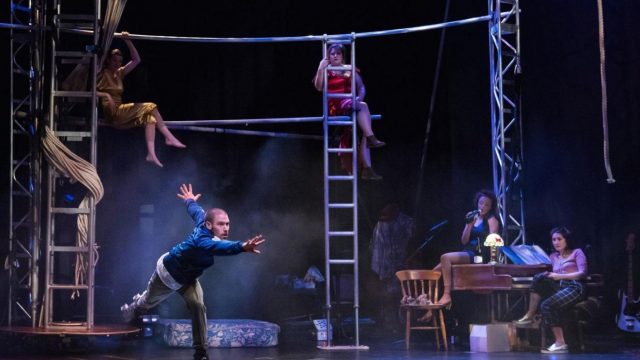CircusFest, Roundhouse, London; 8th April 2018

The new production from Pirates of the Carabina is an exhibition of overlapping portraits, a vision of urban loneliness with some hope for redemption in the possibility of human connection. The Relentless Unstoppable Human Machine of the title? Maybe it’s each individual, who just keeps going, hoping for more. Maybe it’s the city. Or the illuminated tower block that turns at the centre of the stage, providing a gentle carousel of aerial bodies, loosely reaching like circling skydivers, a metropolitan version of the Mexican voladores.
Where a traditional art exhibition may display paintings, this is a curated collection of performance rigging vignettes. Flailing strands of multicord are performing bodies as much as the human form of Seren Corrigan tangling among them. The pulleyed dynamics of counterweighted trapeze, hoop or rope are as essential as the moves executed on either end. A deceptive spiral staircase offers a rough’n’ready slapstick alternative to James Thiérée’s slick manipulations of a similar creation.

The inventiveness of company co-founder Barnz Munn’s set design elements is what gives RUHM (officially pronounced ‘room’, by the way) its distinct character, product of a lineage that can be traced back through his earlier work on Flown, and previously as head rigger for NoFit State. There are so many ideas, however, that none is given a chance to fully show us what it could become.
There is a reason why circus shows, particularly in the UK, evolve so much from their premiere through their run. The resources available for creation restrict the level to which an ambitious project can achieve its goals before bookings must be taken and ticket sales made. I think back to the difference I saw between the first and second times I watched Flown, which the Pirates are still touring internationally. Seams had been smoothed. Nuance had been developed in the moments – and moments between moments – from rawly choreographed action to confident embodiment. While I didn’t want to miss this early performance of RUHM, I suspect I’ll be more impressed with the overall product further down the line.

The moving images are tied together by a bluesy thread of live musical accompaniment, fueling the melancholic air of the show. The disparately dressed cast filter in and out of the band – a dapper Ellis Grover in porkpie hat takes to a drum kit or percussive typewriter when not flicking his long legs around upon the tightwire, as amusingly gangly as his muppet namesake; business-suited Eric McGill perches atop metal-framed structures with an accordian, or flips himself feet first onto a trapeze, performing swinging tricks, but on a bar moving up and down a vertical plane, attached at the other end to Barnz, who hauls and swoops between top and bottom of a sturdy truss frame in counterweight; Jack Rees, in tracksuit jacket and jeans, adds guitar, or finds himself swept away by a pair of red shoes-esque roller skates; everyone takes a turn to sing, including co-founder Shaena Brandel, who is elsewhere seen transporting her serene forest-fairy energy onto a sky bound city hoop, distracted from the world below by her own joy of lift. Song lyrics are the only text in the show, in English and French, and it’s they that give us the suggestion of isolation and desire for companionship that adds context to the action of the highly skilled performers.
For a show built on unexpected feats of physical engineering, there are clunky elements of James Loudon‘s lighting that feel too basic. Squares of light to demarcate neighbouring rooms; a pink and blue lava lamp effect that simultaneously bleeds too much and not enough into the space at the top of the multicord column; twinkling starlight that slots mechanically into place above our heads.

If I return to the gallery analogy (because why should circus always be discussed in theatre’s terms?), some of the work on show is elevated through proximity to what it’s displayed alongside, while other elements could be appreciated more deeply away from their distracting neighbours. Sometimes smokey-voiced composer Meg Ella on the levitating piano interests me more than the aerial acrobatics of human performers. Or the sideline figure of Jade Dunbar clambering up and down the metal truss in a red satin flamenco frock is more interesting than the action centre stage. While the disconnection of the characters is part of the story being shown, it results in a fragmented viewing experience.
The cycle James Williams has directed takes us eventually towards a touching close where, as the beat goes on, the characters each continue their separate lives but with a renewed energy and spirit they lacked at the beginning of our observation, brought about by small moments of kindness and companionship that lighten the load of feeling alone. The sudden desperate face of upbeat gaiety that appears mid Act 2 gives way to more realistic attempts to try and live better in an impersonal and isolating world.

I’m not convinced we need two halves and an interval to get us there and I’m sure the company’s ingenuity could, given time, provide a solution for rigging the tightwire that allows for a continuous, streamlined flow of action. RUHM works best when considered in the light of circus as a concept album. It’s a significant feat for a young company of this scale to succeed at making new work in the UK funding climate and, if it’s not yet cooked to perfection, it does show the company’s ongoing dedication to technical innovation and individuality.
.




